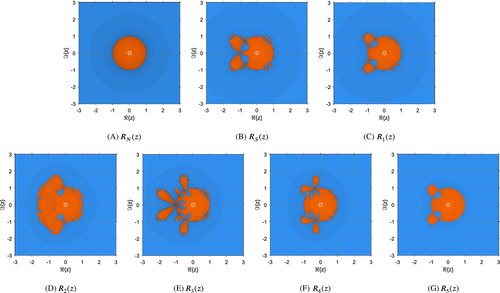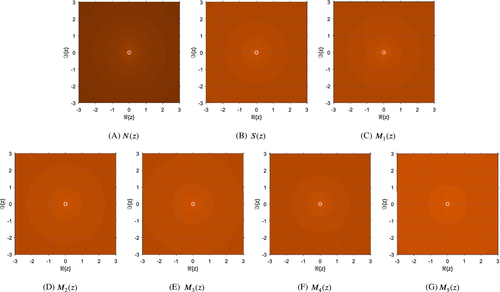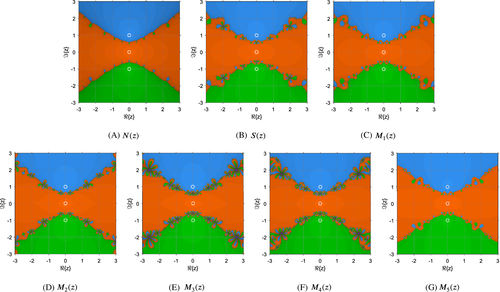On the design and analysis of high-order Weerakoon-Fernando methods based on weight functions
Funding information: MCIU/AEI/FEDER/UE, PGC2018-095896-B-C22
Abstract
In this article, using the idea of weight functions on Weerakoon-Fernando's method, an optimal fourth-order method and some higher order multipoint methods for solving nonlinear equations are proposed. These methods are tested in some real applications and numerical examples and the results are compared with some existing methods. Their dynamical behavior on complex polynomials is analyzed and basins of attraction of these methods are presented.
1 INTRODUCTION
There are various techniques (see References 2-5) for developing new methods and improving the convergence of any iterative method. One of the most effective techniques is the use weight functions. This technique can be applied both on solving nonlinear equations6-9 and systems of nonlinear equations.10-12
In this document, we propose new methods of order 4, 5, 6, and 8 using weight functions and based on the Weerakoon and Fernando method (2). An important ingredient of this article is the dynamical behavior of the introduced methods. It is well known that the dynamical properties of the rational operator give important information about the convergence, efficiency, and stability of the iterative methods. In the last decades, the study of the dynamical behavior of the rational operator associated to an iterative method has become a fast growing area of research (see References 13-17). Furthermore, there is an extensive literature18-21 on the dynamics of rational functions. We discuss the dynamics of the proposed methods.
The article is organized as follows: Section 2 presents the development of the methods and their corresponding error equations. In Section 3, these methods are tested in some Engineering applications and the results are compared with other known methods. Section 4 covers the dynamics of the methods for analyzing their stability. Finally, Section 5 presents the main conclusions.
2 DEVELOPMENT OF METHODS AND THEIR CONVERGENCES
This section is focused on the generation of iterative methods based on (2) A fourth-order method is generated using a weight function in the second step of (2).
Then a third step is introduced from which different iterative schemes are obtained. On the one hand, we apply a structure similar to (2) and introduce only a new functional evaluation, which results in a method of order five. On the other hand, we use a Newton-type expression with a frozen derivative and a weight function, obtaining two order six methods. Finally, if we directly include Newton's method as a third step we obtain an eighth-order method.
2.1 Fourth-order method
Below we prove the convergence of method (5).
Theorem 1.Let f be a complex valued function defined on some interval I having sufficient number of smooth derivatives. Let be a simple root of the equation f(x) = 0. Then method (5) is of order four if , , and .
Proof.Let en be the error in xn. Denote . Then in view of Taylor's series expansion, we have
2.2 Fifth-order method
Theorem 2.Let f be a complex valued function defined on some interval I having sufficient number of smooth derivatives. Let be a simple root of the equation f(x) = 0. Then method (14) has fifth-order of convergence.
2.3 Sixth-order method
Theorem 3.Let f be a real or complex valued function defined on some interval I having sufficient number of smooth derivatives. Let be a simple root of the equation f(x) = 0. Then, method (18) is of order six, if and . In addition, method (19) is of order six, if .
Proof.It is easy to calculate from (7), (9) to (16), that
2.4 Eighth-order method
Theorem 4.Let f be a real or complex valued function defined on some interval I having sufficient number of smooth derivatives. Let be a simple root of the equation f(x) = 0. Then method (24) has eighth-order of convergence.
Proof.Taylor's series expansion of about by using (15) gives
Table 1 collects a comparison of the methods introduced over this section. The comparison is performed in terms of order of convergence (p) and efficiency index (), where nf is the number of functional evaluations per iteration. Newton's (1) and Sharma's (4) methods are also included for the sake of comparison, denoted by N and S, respectively. The introduced methods given by (13), (14), (22), (23), and (24) are denoted by M1, M2, M3, M4, and M5, respectively.
| Methods | N | S | M1 | M2 | M3 | M4 | M5 |
|---|---|---|---|---|---|---|---|
| nf | 2 | 3 | 3 | 4 | 4 | 4 | 5 |
| p | 2 | 4 | 4 | 5 | 6 | 6 | 8 |
| E | 1.414 | 1.587 | 1.587 | 1.495 | 1.565 | 1.565 | 1.516 |
3 APPLICATIONS AND EXAMPLES
In this section, numerical tests on the introduced methods are performed. In Subsections 3.1, 3.2, and 3.3 the methods are applied on standard engineering examples.22 Subsection 3.4 covers a set of analytical examples. In all tables, BE(− A) stands for B × 10−A and Mi, i = 1,2,3,4,5 represent the methods of order 4, 5, 6, 6, and 8, respectively.
3.1 Parachutist's problem
The total force F acting on a falling parachutist is the sum of two opposite forces, namely, the downward force due to gravity Fd and the upward force due to air resistance Fu, so that F = Fd + Fu.
The force due to gravity is given by Fd = mg, where g ≈ 9.8 m/s2 is the acceleration due to gravity and m is the mass of the parachutist. Air resistance can be assumed to be linearly proportional to the velocity v and acts in an upward direction, so Fu = −cv, where c is the proportionality constant called the drag coefficient (kg/s) and the negative sign indicates the upward direction. The parameter c is responsible for the properties of the falling object, such as the shape or surface roughness, which affect air resistance. In the case of parachutist, c may be the type of jumpsuit or the orientation used by the parachutist during free-fall.
| #Iteration | Results | M1 | M2 | M3 | M4 | M5 |
|---|---|---|---|---|---|---|
| 1 | c | 12.2715 | 12.4266 | 12.4616 | 12.4955 | 12.5310 |
| f(c) | 0.4859 | 0.1969 | 0.1321 | 0.0695 | 0.0042 | |
| 2 | c | 12.5333 | 12.5333 | 12.5333 | 12.5333 | 12.5333 |
| f(c) | 3.8857 E(−7) | 5.2061 E(−11) | 5.6843 E(−14) | 0.0 | 0.0 | |
| 3 | c | 12.5333 | 12.5333 | 12.53337 | 12.5333 | 12.5333 |
| f(c) | 0.0 | 0.0 | 0.0 | 0.0 | 0.0 |
3.2 Open-channel flow
An open problem in civil engineering is to relate the flow of water with other factors affecting the flow in open channels such as rivers or canals. The flow rate is determined as the volume of water passing a particular point in a channel per unit time. A further concern is related to what happens when the channel is slopping.
| #Iteration | Results | M1 | M2 | M3 | M4 | M5 |
|---|---|---|---|---|---|---|
| 1 | y | 1.4701 | 1.4656 | 1.4653 | 1.4653 | 1.4650 |
| f(y) | 0.0690 | 0.0080 | 0.0038 | 0.0032 | 0.0000 | |
| 2 | y | 1.4650 | 1.4650 | 1.4650 | 1.4650 | 1.4650 |
| f(y) | 5.5427 E(−11) | −3.5527 E(−15) | −3.5527 E(−15) | 1.7763 E(−15) | 1.7763 E(−15) | |
| 3 | y | 1.4650 | 1.4650 | 1.46506 | 1.4650 | 1.4650 |
| f(y) | −3.5527 E(−15) | −3.5527 E(−15) | −3.5527 E(− 15) | 1.7763 E(−15) | 1.7763 E(−15) |
3.3 Design of an electric circuit
A common problem in electrical engineering is the study of the steady state behavior of electric circuits. The voltages VR, VL and VC are the potentials across the resistor R, the inductor L, and the capacitor C, respectively. It is known that VR = iR, , and , where q is the charge and is the flow of current.
Let us assume that the appropriate resistor R is required to be determined with known values of L = 5H and C = 10−4F and C. Moreover, we take , that is, the charge must be dissipated to 1% of its original value in time t = 0.05s. We choose the initial guess for the resistance . The results obtained from first three iterations by using the methods Mi are presented in Table 4.
| #Iteration | Results | M1 | M2 | M3 | M4 | M5 |
|---|---|---|---|---|---|---|
| 1 | R | 304.7563 | 314.9646 | 317.5493 | 320.8943 | 327.1815 |
| f(R) | −0.0243 | −0.0134 | −0.0107 | −0.0073 | −0.0009 | |
| 2 | R | 328.1494 | 328.1514 | 328.1514 | 328.1514 | 328.1514 |
| f(R) | −1.9369 E(−6) | −6.3306 E(−9) | −1.5278 E(−10) | −5.2303 E(−12) | −5.0306 E(−17) | |
| 3 | R | 328.1514 | 328.1514 | 328.1514 | 328.1514 | 328.15142908514815 |
| f(R) | 3.2959 E(−17) | 3.2959 E(−17) | 3.2959 E(−17) | 3.2959 E(−17) | −5.0306 E(−17) |
3.4 Further examples
- f7(x) = (x − 1)3 − 1.
The stopping criteria for the iterative process has been set in The details of the work are presented in Table 5. The values displayed are the initial guess x0, the number of iterations n for achieving the stopping criteria, and the approximated computational order of convergence ACOC.23 The value NA in ACOC stands for Not Available, because the number of iterates is not enough for its calculation.
| f4(x) | f5(x) | f6(x) | f7(x) | ||
|---|---|---|---|---|---|
| Methods | (x0 = 3.0) | (x0 = 1.0) | (x0 = 1.5) | (x0 = 3.0) | |
| N | n | 5 | 7 | 5 | 7 |
| 0.444E − 15 | 0.0 | 0.444E − 15 | 0.0 | ||
| xn + 1 | 2.331967655883964 | 1.857183860207835 | 2.447748286452425 | 2.0 | |
| |f(xn + 1)| | 0.888E − 15 | 0.0 | 0.0 | 0.0 | |
| ACOC | 2.046848 | 2.000437 | 1.853573 | 2.001497 | |
| S | n | 3 | 4 | 3 | 4 |
| 0.888E − 15 | 0.444E − 15 | 0.444E − 15 | 0.768E − 13 | ||
| xn + 1 | 2.331967655883964 | 1.857183860207835 | 2.447748286452425 | 2.0 | |
| |f(xn + 1)| | 0.888E − 15 | 0.0 | 0.0 | 0.0 | |
| ACOC | 3.848687 | 3.202382 | 3.776679 | 3.914934 | |
| M1 | n | 3 | 4 | 3 | 4 |
| 0.888E − 14 | 0.0 | 0.222E − 14 | 0.111E − 13 | ||
| xn + 1 | 2.331967655883964 | 1.857183860207835 | 2.447748286452425 | 2.0 | |
| |f(xn + 1)| | 0.888E − 14 | 0.0 | 0.222E − 15 | 0.0 | |
| ACOC | 4.018510 | 3.702951 | 4.026750 | 3.932947 | |
| M2 | n | 3 | 4 | 3 | 4 |
| 0.0 | 0.0 | 0.0 | 0.0 | ||
| xn + 1 | 2.331967655883964 | 1.857183860207835 | 2.447748286452425 | 2.0 | |
| |f(xn + 1)| | 0.888E − 15 | 0.222E − 15 | 0.0 | 0.0 | |
| ACOC | NA | 4.601259 | NA | 3.975725 | |
| M3 | n | 3 | 4 | 3 | 4 |
| 0.0 | 0.0 | 0.0 | 0.0 | ||
| xn + 1 | 2.331967655883964 | 1.857183860207835 | 2.447748286452425 | 2.0 | |
| |f(xn + 1)| | 0.888E − 15 | 0.222E − 15 | 0.0 | 0.0 | |
| ACOC | NA | 5.280387 | NA | 4.486354 | |
| M4 | n | 3 | 4 | 3 | 4 |
| 0.0 | 0.0 | 0.888E − 15 | 0.0 | ||
| xn + 1 | 2.331967655883964 | 1.857183860207835 | 2.447748286452425 | 2.0 | |
| |f(xn + 1)| | 0.888E − 15 | 0.0 | 0.222E − 15 | 0.0 | |
| ACOC | NA | 5.495705 | NA | 4.777322 | |
| M5 | n | 3 | 3 | 3 | 3 |
| 0.0 | 0.444E − 15 | 0.0 | 0.4E − 14 | ||
| xn + 1 | 2.331967655883964 | 1.857183860207835 | 2.447748286452425 | 2.0 | |
| |f(xn + 1)| | 0.888E − 15 | 0.0 | 0.0 | 0.0 | |
| ACOC | NA | 5.657281 | NA | 6.827861 | |
4 DYNAMICS OF THE METHODS
In this section, we discuss the dynamics of the methods presented in Section 2 and compare them with some of the existing methods.
4.1 Basics on complex dynamics
Below, some preliminaries of complex dynamics are presented. For further information, see References 21, 24.
For any rational function f(z), a point z0 is called a fixed point if f(z0) = z0. The critical points of f(z) are those points that satisfy . The critical points may or may not coincide with the fixed points. Fixed and critical points are not necessarily the roots of f(z) = 0. In this case, they are called strange fixed and free critical points, respectively. A fixed point z0 of f(z) is superattracting, attracting, repelling or neutral if . . or , respectively.
Let be a rational function, where is the Riemann sphere. Successive iterations of R over z are called orbits and are given by the sequence {z,R(z),R2(z),R3(z),…}. When iterative methods for solving nonlinear equations are applied on polynomials, they result in a rational function, commonly known as the rational operator. The above considerations for fixed and critical points can be directly extended to rational functions.
4.2 Fixed and critical points
The strange fixed points of any operator may complicate the root finding procedure. If they have an attracting behavior, they may can trap an iteration sequence, giving incorrect results for a z∗ root of the p(z) polynomial. Even as the repulsive or neutral fixed points, however, they may alter the structure of the basin of attraction for the roots.25 Generally, increasing the order of convergence of any method increases the number of strange fixed points, which may adversely affect the basin of attraction of the method.16
4.3 Conjugacy classes
The methods presented in this article verify the Scaling Theorem. By Mip, we denote the method Mi when applied on the polynomial p(z).
Theorem 5.(Scaling theorem): Let T(z) = az + b, a ≠ 0 be an affine map in the Riemann sphere , and let be a nonzero constant. Let p(z) be a polynomial defined in . Define . Then
Proof.We shall prove the assertion for M1 only. For other Mi, it can be proved similarly. We have
Verification of the scaling theorem involves how the methods for a given polynomial relate to the methods for a rescaled polynomial. In other words, we can transform the roots into a related map without qualitatively changing the dynamics of the corresponding methods.21, 26
4.3.1 Corresponding conjugacy class for quadratic polynomials
Newton's method Np(z) on any quadratic polynomial p(z) is conjugate to the quadratic polynomial z2.21 Moreover, method Sp(z) is conjugate to . In this way, RN(z) and RS(z) refer to the application of the Scaling Theorem to Np(z) and Sp(z), respectively. We show that methods Mip(z) on quadratic polynomials have more complicated expression for the conjugacy classes. The results are proved in the following theorem.
Theorem 6.Let p(z) = (z − a)(z − b) with a ≠ b, be a quadratic polynomial. Then, the operators Mip(z) with i = 1, 2, 3, 4, 5 are conjugated to the rational maps Ri(z) with i = 1, 2, 3, 4, 5, respectively. Their expressions are
Proof.We prove the result for M1(z) only. The rest of cases can be proved similarly.
Consider the Möbius transformation given by Note that . Then
4.4 Basins of attraction
In our work, we use Mathematica 9.0 for the symbolic calculations, while the representations of the basins of attraction, that follows the guideline of Reference 27, are performed with Matlab R2017b. We divide the complex plane into 500 × 500 initial points in the domain to determine the basins of attraction of the roots of the polynomials. Each root of the polynomial is mapped to a different color. If an initial guess tends to a root of the polynomial, this point is represented with its corresponding color. Indeed, the dynamical planes include information about the number of iterations required to converge to the root: the more iterations required, the darker color.
4.4.1 Dynamical analysis applying the methods on quadratic polynomials
The rational maps of Theorem 6 correspond to the rational functions of the introduced methods when they are applied to quadratic polynomials. In every case, is a superattracting fixed point. As introduced in Reference 14, is also a superattracting fixed point. The rest of fixed points are repelling, improving the stability of the method. The number of fixed and critical points is displayed in Table 6.
| Method | N(z) | S(z) | R2(z) | R3(z) | R4(z) | R5(z) | R6(z) |
|---|---|---|---|---|---|---|---|
| #EFP | 1 | 5 | 5 | 11 | 13 | 11 | 11 |
| #FCP | 0 | 3 | 4 | 14 | 13 | 8 | 6 |
Since every strange fixed point is repelling, their presence does not affect negatively to the stability of the corresponding methods. In order to verify this fact, and also to analyze the shape and width of the basins of attraction, Figure 1 represents the dynamical planes of the introduced methods. Note that the orange color is devoted to the root and the blue one corresponds to the superattracting point .

4.4.2 Dynamical analysis applying the methods on cubic polynomials
When the rational functions are applied on cubic polynomials, the resulting expressions are in terms of the original method instead of using their Möbius transform. In order to analyze a complete behavior over the cubic polynomials, the iterative methods are applied on p•(z) = z3, p+(z) = z3 + z, and p−(z) = z3 − z, as performed in Reference 28.
In the p•(z) case, there is no presence of fixed points, but the root , that is, superattracting, and the z2 = ∞, whose behavior is repelling.
When the polynomial p+(z) is applied, the roots and are superattracting points. As in the previous polynomial, the point z2 = ∞ is a repelling point. In this case, there is a big presence of extraneous fixed points, but they behave in a repelling way.
Finally, the application of the methods on the polynomial p−(z) gives a similar performance than in the p+(z) case. The roots and are superattracting, the point z2 = ∞ is repelling, and the rest of strange fixed points are also repelling. Table 7 gathers the information about the extraneous fixed points and free critical points when the three polynomials are applied on the introduced methods.
| p(z) | Method | N(z), | S(z) | R2(z) | R3(z) | R4(z) | R5(z) | R6(z) |
|---|---|---|---|---|---|---|---|---|
| p•(z) | #EFP | 0 | 0 | 0 | 0 | 0 | 0 | 0 |
| #FCP | 0 | 0 | 0 | 0 | 0 | 0 | 0 | |
| p+(z) | #EFP | 0 | 12 | 12 | 42 | 48 | 42 | 42 |
| #FCP | 0 | 12 | 18 | 44 | 48 | 42 | 42 | |
| p−(z) | #EFP | 0 | 12 | 12 | 42 | 48 | 42 | 42 |
| #FCP | 0 | 12 | 18 | 44 | 48 | 44 | 22 |
Figures 2-4 represent the dynamical planes of the introduced methods. In Figure 2 a unique basin of attraction can be observed, due to the polynomial p•(z) = z3 has only a superattracting point in . Therefore, every initial guess whose orbit tends to this root is represented in orange.

The stability of every method, when they are applied on p•(z), is verified in the complete plane, as pictured in Figure 2. Note that every initial guess in the complex plane tends to the superattracting point .
Figure 3 illustrates the dynamical planes of methods M1 − 5(z) when they are applied on p+(z) = z3 + z. In this case, there are three superattracting points: is mapped to color orange, is mapped to color blue, and is mapped to color green.

The dynamical planes of Figure 3 confirm the theoretical analysis. There is not any fixed point different to the roots that attracts any orbit. All initial estimates tend to one of the three superattracting points, showing the wide region of stability of every method. The methods of order 6 show a more intricated Julia set than the other ones. However, when the order is increased, this behavior is not observed. The composition with Newton's method makes the borderlines of the dynamical planes smoother.
Finally, Figure 4 represents the dynamical planes of the methods when they are applied on p−(z) = z3 − z. In this case, the orange basin remains with , while blue and green basins are referred to and , respectively.

The features of Figure 4 coincide with Figure 3 corresponding ones. Note that the planes of Figure 4 are just a rotation of the planes of Figure 3.
5 CONCLUSIONS
A new set of iterative methods, based on Weerakoon and Fernando method, have been introduced. These methods, of different orders of convergence, have been checked by numerical and stability tests. On the one hand, the numerical performance makes evident the power of these methods, as they all converge to the expected root and reduce the number or iterations compared with Newton's method. On the other hand, the stability analysis, carried out in terms of complex dynamics, shows that every initial guess tends to a superattracting point that matches with the root of the corresponding polynomial. This fact is due to the absence of strange fixed points that behave attracting in both quadratic and cubic polynomials.
ACKNOWLEDGEMENTS
This research was supported by PGC2018-095896-B-C22 (MCIU/AEI/FEDER/UE).
CONFLICT OF INTEREST
The authors declare no potential conflict of interests.
Biographies

Prem B. Chand is a PhD candidate in the Department of Mathematics, South Asian University, New Delhi, India. He is a professor of Mathematics in National Academy of Science and Technology (Pokhara University), Nepal. His current research is concerned with Numerical Analysis and Scientific Computing. He is author of more than four research articles in the field of numerical analysis and computing.

Francisco I. Chicharro received his PhD in mathematics in 2017 and his PhD in telecommunications in 2018, both at Universitat Politècnica de València, Spain. He is the head of the Computational Mathematics Degree at Universidad Internacional de La Rioja UNIR, Spain. He is author of more than 20 research articles covering the areas of computational mathematics and optical transmission of OFDM signals.

Pankaj Jain is a Professor of Mathematics at South Asian University, New Delhi, India. His research interests include numerical analysis, Fourier analysis, function spaces, weighted norm inequalities and applications of these areas. He has published over 75 research articles in these areas.




